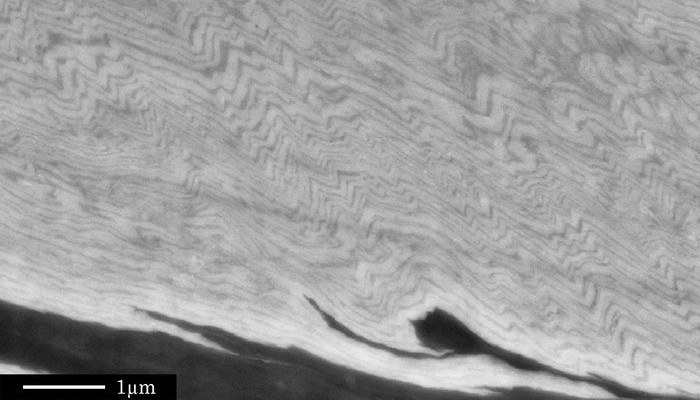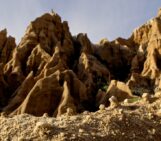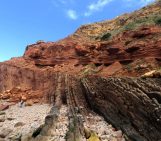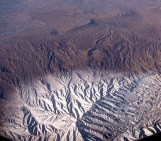
Tiny crinkly folds form the main basis of today’s Imaggeo on Mondays. Folding can occur on a number of scales; studying folds at all scales can reveal critical information about how rocks behave when they are squeeze and pinched, as described by Sina Marti, from the University of Basel.
Although many geoscientists have seen such fold structures many times before, if you noticed the scale bar in the lower left of the image, you might be surprised of the small scale of these folds!
The presented image is a high-magnification image taken on an electron microscope, showing sub-micrometer scale folds developed within a deformed pyroxene grain – a chain silicate mineral, for example common in the oceanic crust of the earth. The folded layers are primary exsolution lamellae of more calcium rich and calcium poor chemical composition. These lamellae formed during the early, magmatic history of the pyroxene grain, where it crystallized and cooled down in a shallow intrusion. The folding subsequently took place during deformation and the following text will try to give a short overview on why and how these folds have formed.
The presented image was made using a back-scattered electron (BSE) detector, where different grey values indicate different chemical compositions. This effect originates from the fact, that some of the electrons, which “bombard” the sample in the electron microscope, are back scattered by the atoms near the sample surface and then detected by the BSE. Heavier atoms (with a greater atomic number, Z) have a higher probability to generate a backscattered electron. Consequently, where heavy atoms occur, more backscattered electrons reach the detector and the area appears bright, compared to dark- appearing areas, where light atoms prevail. Because of this sensitivity of the BSE image on chemical composition, we can see the exsolution lamellae in the pyroxene with different grey values.
Although the folds in this image occur on the nanometer- to micrometer scale, their geometry and mode of formation is the same as is observed in large-scale fold belts (e.g. the Helvetic nappes in the Swiss Alps). There, this fold type develops mainly in layered sediments, which have contrasting properties: alternating series of competent and incompetent layers leads to boundary instabilities and thus to folding. In the present case, the contrasting properties of the layers – also known as anisotropy – is a result of the formation of the exsolution lamellae and enables folding even at the very small scales seen within this single grain. One can even see the difference between the layers in the image: The darker lamellae change their layer thickness more readily (best seen in fold hinges – the place of strongest bend in the fold) than the brighter layers, indicating that the darker layers deform more easily..
This folded pyroxene is an astonishing example that certain processes, which generate geological structures, operate over multiple orders of magnitude in scale. Without a scale bar provided, it would not be possible to determine the scale of these structures and tell them apart from folds formed in outcrop or even on larger scales. Now, it should not be confused: such a pyroxene grain will not be encountered in the same tectonic regime as large-scale fold belts. But exactly for this reason, it is a beautiful example displaying the overall controlling importance of anisotropy over most other material properties, independent of scale. For the deformation of rocks, anisotropy almost always plays a key role in the deformability, and in general controls the development of structures such as folds like in the present case.
By Sina Marti, Department of Environmental Science, Geological Institute, Basel
Sina would like to thank the Center of Microscopy (ZMB) at the University of Basel, where the image was taken and also thank the ZMB for providing the infrastructure.
Imaggeo is the EGU’s online open access geosciences image repository. All geoscientists (and others) can submit their photographs and videos to this repository and, since it is open access, these images can be used for free by scientists for their presentations or publications, by educators and the general public, and some images can even be used freely for commercial purposes. Photographers also retain full rights of use, as Imaggeo images are licensed and distributed by the EGU under a Creative Commons licence. Submit your photos at http://imaggeo.egu.eu/upload/.



